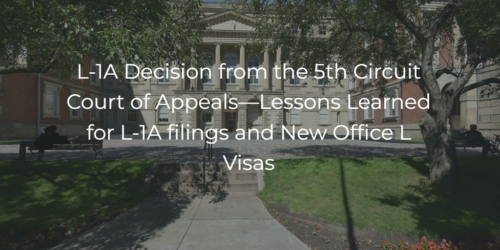
L-1A Decision from the 5th Circuit Court of Appeals—Lessons Learned for L-1A filings and New Office L Visas
In a September 21, 2022 opinion from the 5th Circuit Court of Appeals, the 5th Circuit essentially upheld the denial of an L-1A petition. The entirety of the Court’s opinion can be found here: https://www.ca5.uscourts.gov/opinions/unpub/21/21-10116.0.pdf. While much of it discusses legal elements that would not impact most L-1A petitioners, such as mootness in court, there are elements of the decision that provide some good insight for L-1 filings.
The background of the case is as follows. BlueStar is a U.S. affiliate of Krishna Textile. BlueStar filed an L-1A executive petition on behalf of the CEO of Krishna Textile, Mr. Jigneshkumar Lodaliya. This petition was filed as a “new office” L-1A. See 8 C.F.R. 214.2(l)(1)(ii)(F ) (defining “new office”). BlueStar was seeking to have Mr. Lodaliya come to the US to assume the role of CEO of BlueStar. In support of the original petition, BlueStar submitted an affidavit from Mr. Lodaliya describing his role at Krishna Textile and his upcoming role at BlueStar, an organizational chart of Krishna Textile, and a business plan for BlueStar including a planned organizational chart and detailed financial forecasts. As is common with L-1s, USCIS sent a Request for Evidence (RFE). The RFE pointed out (1) that most of the documents that had been submitted were self-generated, meaning USCIS alleged they had no independent value; (2) the documents were not detailed enough to prove that Mr. Lodaliya was acting in an executive capacity with Krishna Textile; and (3)BlueStar’s documents were similarly not detailed enough. BlueStar responded to the RFE with an additional affidavit from Mr. Lodaliya and a letter from an accounting testifying to Mr. Lodaliya’s ownership of Krishna. USCIS denied the petition on two grounds: first, the evidence fails to establish that Mr. Lodaliya’s position with Krishna Textile was executive or managerial, and second, that the evidence fails to establish that BlueStar would be able to support an executive or managerial position within one year. Following the denial, BlueStar sued in District Court, but the denial was eventually upheld by the District Court, and BlueStar appealed. Ultimately, the Circuit Court upheld the denial as well, but there are some takeaways in the denial.
When discussing USCIS’s claim that the lawsuit was moot, a legal term meaning there is no live controversy, the Court provides some insight on new office L-1s. 8 C.F.R. 214(l)(1)(ii)(F) defines “new office” for purposes of L-1s. The Court concludes that “the evidence needed to support an application for a new office l-1A visa is the exact same as that needed for an existing office L-1A visa except that the new-office petitioner must include some extra information not required of the existing petitioner.” The Court looks to 8 C.F.R. § 214(l)(3)(v) that lists the evidence that must be submitted for a new office petition. That evidence includes evidence that:
(A) Sufficient physical premises to house the new office have been secured;
(B) The beneficiary has been employed for one continuous year in the three year period preceding the filing of the petition in an executive or managerial capacity and that the proposed employment involved executive or managerial authority over the new operation; and
(C) The intended United States operation, within one year of the approval of the petition, will support an executive or managerial position as defined in paragraphs (l)(1)(ii) (B) or (C) of this section, supported by information regarding:
(1) The proposed nature of the office describing the scope of the entity, its organizational structure, and its financial goals;
(2) The size of the United States investment and the financial ability of the foreign entity to remunerate the beneficiary and to commence doing business in the United States; and
(3) The organizational structure of the foreign entity.
With this, it is important to keep in mind that when filing for a new office L visa the entity have sufficient evidence to be able to prove they meet the above regulatory requirements.
Moving on to the merits of the case, the Court looked at the original denial letter. It is important to understand the reasons USCIS denied the petition. Ultimately, the denial was on two independent grounds, but USCIS looked to three key factors
- USCIS denied the petition because providing evidence of ownership of Krishna Textile does not, by itself, establish executive or managerial capacity
- USCIS looked to the position description of Mr. Lodaliya and that of his subordinates, and determined that the job descriptions did not establish that he was acting in an executive capacity at Krishna Textile or that he would continue to work in such a position at BlueStar. USCIS reasoned that it was not clear that there were enough subordinates available to handle the day-to-day aspects of the job
- USCIS looked to the fact that BlueStar estimated they had first year operating costs of $300,000 but Krishna Textile only had net assets of a little more than $100,000. USCIS concluded that this was not sufficient to sustain the business for a year and could not support an executive position.
The Court looked to the regulations to determine if USCIS’s denial was proper, and held that it is, and it is important to look into these reasons. USCIS found “The evidence, in its totality, must establish that the beneficiary performed the level of responsibility outlined in these regulations. . . . The position descriptions you provided in the affidavit do not sufficiently demonstrate . . . how these positions relieve him from performing the day-to-day responsibilities of the operation. . . . Therefore, you have not demonstrated that the foreign entity has an organizational structure sufficient to elevate the beneficiary to an executive position as defined by the [INA].”
The Court found the logic to be in line with the INA and the regulations. The Court looked to 8 C.F.R. § 214.2(l)(1)(ii)(C) and found that Mr. Lodaliya must be primarily directing the management of Krishna Textile, and that he must be relieved of the focus on day-to-day functions. Essentially, executives should focus on the broad goals of the organization, not day-to-day operations.
Next, BlueStar contends that USCIS erred when looking to the responsibilities of Mr. Lodaliya’s subordinates to determine if he was an executive. USCIS contended that executive capacity is a higher office than managerial capacity, and therefore they can look to determine whether the subordinates of an executive are managers to determine if the beneficiary “directs the management of the organization…” as is mentioned in 8 C.F.R. § 214.2 (l)(1)(ii)(C). The Court agreed with USCIS and another court’s opinion finding that “the definition [of executive] requires a level of staffing that has a subordinate management structure allowing the executive employee to direct other managers and to focus on the broad goals of the organization rather than its day-to-day functions.” The Court also looked at BlueStar’s complaint that USCIS should not use the size of the company to determine if Mr. Lodaliya was an executive. The Court found that staffing levels may be “used as a factor in determining whether an individual is acting in a managerial or executive capacity.”
Finally, the Court looks to USCIS’s assessment on the new office portion of the petition. 8 C.F.R. § 214.2(l)(3)(v)(C)(2) requires that petitioners show evidence of “the size of the United States investment and the financial ability of the foreign entity to remunerate the beneficiary and to commence doing business in the United States.” Here, USCIS looked at Krishna Textile’s net assets of a little more than $100,000. However, BlueStar’s business plan showed that the estimated operating costs of the company would be $300,000. The Court agreed with USCIS’s decision noting that it does not take a business expert to understand USCIS’s rationale for denying the case on this ground.
Essentially, there are four major takeaways that are important for L-1A filings and new office petitions.
Lesson 1: Executives should be focused on broad goals of the organization, not day-to-day operations
Lesson 2: One way to show the position is executive is to show that the beneficiary is managing managers in a way that would allow the executive to focus on the broad goals of the organization while the managers focus on the day-to-day.
Lesson 3: USCIS will look to the size of the company and staffing levels to determine if there is sufficient staffing to raise the beneficiary to the level of an executive.
Lesson 4: Ensure that the foreign entity or the investments in the US entity provide sufficient funding to sustain the business in the US and submit proof of that.
If you are interested in an L-1A petition, reach out to our team to discuss your company on how we can leverage your foreign entities and US entities to employ your managers or executives in the US.
Reddy & Neumann has been serving the business community for over 20 years and is Houston’s largest immigration law firm focused solely on U.S. Employment-based immigration. We work with both employers and their employees, helping them navigate the immigration process quickly and cost-effectively.
Steven Brown is a Partner at Reddy Neumann Brown PC where he works in the Non-immigrant visa department and leads the Litigation Team. His practice covers all phases of the non-immigration visa process including filing H-1B, L-1, E-3, H-4, and H-4 EAD petitions. In the last two years, Steven has successfully handled over 1,000 non-immigrant visa petitions including filing petitions, responding to any necessary Requests for Evidence, and drafting motions and appeals. He has also become a key resource for F-1 students that seek guidance on properly complying with the F-1 visa regulations and any OPT or CPT issues they may have. Additionally, Steven holds a weekly conference call for companies that are part of one of the largest organizations for IT Services companies in America.
Reddy & Neumann has been serving the business community for over 20 years and is Houston’s largest immigration law firm focused solely on US. Employment-based immigration. We work with both employers and their employees, helping them navigate the immigration process quickly and cost-effectively

